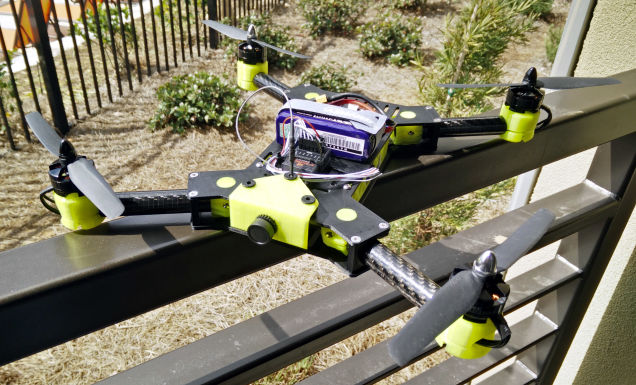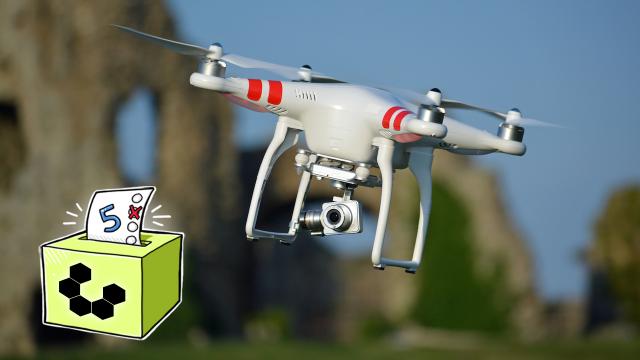Drones (unmanned aerial vehicles or UAVs if you’re being formal) are becoming increasingly affordable. Whether you’re getting into drones because you want to take awesome video of your community, do some neighbourhood mapping, or just fly something cool looking through the skies, you have lots of great options. This week we’re looking at five of the best, based on your nominations.
Title photo by Vicki Burton
Reminder: whichever drone you choose, make sure you obey the law about where you can fly it. As with any gadget purchase, shop around online to find the best pricing (and don’t forget to factor in shipping).
Lumenier QAV250
The Lumenier QAV250 isn’t a beginner’s drone, but if you’re a hobbyist, a DIY-er, love FPV (first-person view) flying, or just like to get hands on, you’ll love this. This UAV encourages you to make your own modifications so it suits your specific needs. The QAV250 is a unibody quadcopter frame that you can buy either on its own, or as part of a kit with everything else you’ll need to get it flying. Depending on the type of flying you want to do, you can buy different components and parts to get your custom model to handle the way you want it to — whether you’re interested in acrobatics, trick flying, pure speed, long range, or beautiful video.
The frame can fully support an HD camera too — in fact, the QAV250 offers multiple camera mounts. It’s also a light airframe, weighing just 170 grams before you start loading it up with gear, and around 540 grams when fully loaded. It has its own landing gear and LED strips to help keep you oriented. Check out this this awesome flight video for an example of its work.
DJI Phantom 2 Vision+
The DJI Phantom 2 Vision and Vision+ are also probably not the most beginner-friendly drones, but they are the ones you’ll probably see in photos and videos when people start talking about the category. The Vision+ earned The Wirecutter’s “Best Drone” pick, because of its range and battery power, stability and learning curve, mobile app support (you can mount your phone right on the receiver and see what the Phantom sees, FPV-style), customisation options and durability. All of those fancy HD videos you see on blogs of city skylines and such? Probably shot with one of these.
The Phantom models give you up to a half-hour of flying time on your first battery, great range and speed, built-in camera stabilisation, the ability to plot a “flight path” using your smartphone and receiver, fine control over the camera while you fly, and the ability to grab photos and videos from your Phantom as soon as it lands, via Wi-Fi. They’re not cheap though, so definitely shop around.
BLADE Nano QX RTF
BLADE’s Nano QX RTF is an simple, affordable quadcopter that’s a great beginner’s drone if you’re interested in getting into the hobby with a durable, tough-to-break but easy-to-master model. The Wirecutter suggested it for beginners in its article on the best drones, and Tom’s Guide says it’s the best for the money.
Part of the reason it’s so beginner-friendly is that BLADE has integrated automatic stability controls (in the form of “Sensor Assisted Flight Envelope” or “SAFE” technology) along with a light, tough airframe and prop guards to help keep it sturdy and in good flying condition regardless of what you do with it. The Nano QX RTF is also a tiny drone — about palm-sized, so you can fly it indoors or outdoors
Parrot Bebop Drone
Parrot is the maker of some of the most recognisable drones (including the Parrot AR Drone). The recently-released Parrot Bebop is a medium-sized drone with an integrated camera that’s easy to fly and versatile, but also offers FPV piloting and support for both Parrot’s own SkyController unit and using your smartphone or tablet to pilot the Bebop. It’s small enough to fly indoors, and the 14MP integrated fisheye HD camera on the front is excellent at capturing the detail of anything you pass over (or through.)
It’s a lightweight drone, built for stability rather than agility, and the discrete controls allow you to pan your camera view while keeping the drone itself level and steady. The drone even generates its own Wi-Fi hotspot, which is a fairly impressive feat. Despite its price, the Bebop is a nice middle ground between more expensive, high-end models that take skill to pilot, and the lower-end plastic models for beginners.
DIY

If ready-to-fly options don’t appeal or you’re short on cash, consider the DIY option. With some elbow grease, the right tools, and the help of a massive community of enthusiasts, you can build your own drone to do whatever you want — whether you’re interested in racing and agility, long distance and range, carrying capacity, or beautiful HD video. Once you start researching DIY drones and models you can assemble yourself, you quickly dive into a world of custom motors and rotors, electrical systems, lightweight batteries and durable airframes, and cameras and gimbals to help you capture video while you fly.
DIY Drones is a good place to start — one we have mentioned once or twice in the past, as is the DIYDrones subreddit.
Want to make the case for your personal favourite drone, even if it wasn’t included in the list? Tell us what you use and why it’s so great in the comments.

Comments
One response to “Five Best Drones”
dont suppose its too much to ask to add in some price points.
This is a great article, but if you’re looking for prices (and drones in a lower price range), we just published an article you might get a lot out of: http://uavcoach.com/cheap-drones-for-beginners/
We would love to know what you think, and don’t hesitate to get in touch if you need help with anything.
Hey, I am amazed to see DJI products on every page on the internet. Drones are trending on the internet.. I have also trimmed a list of best drones in australia ,,Hope this also helps someone in Australia